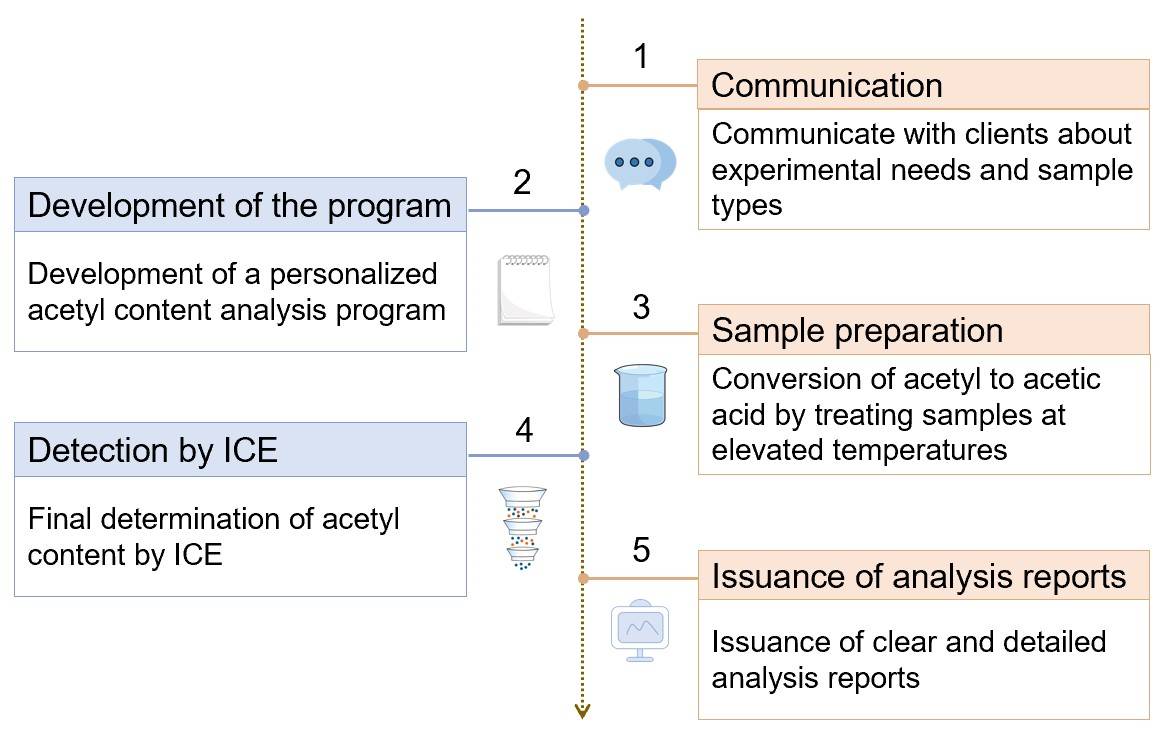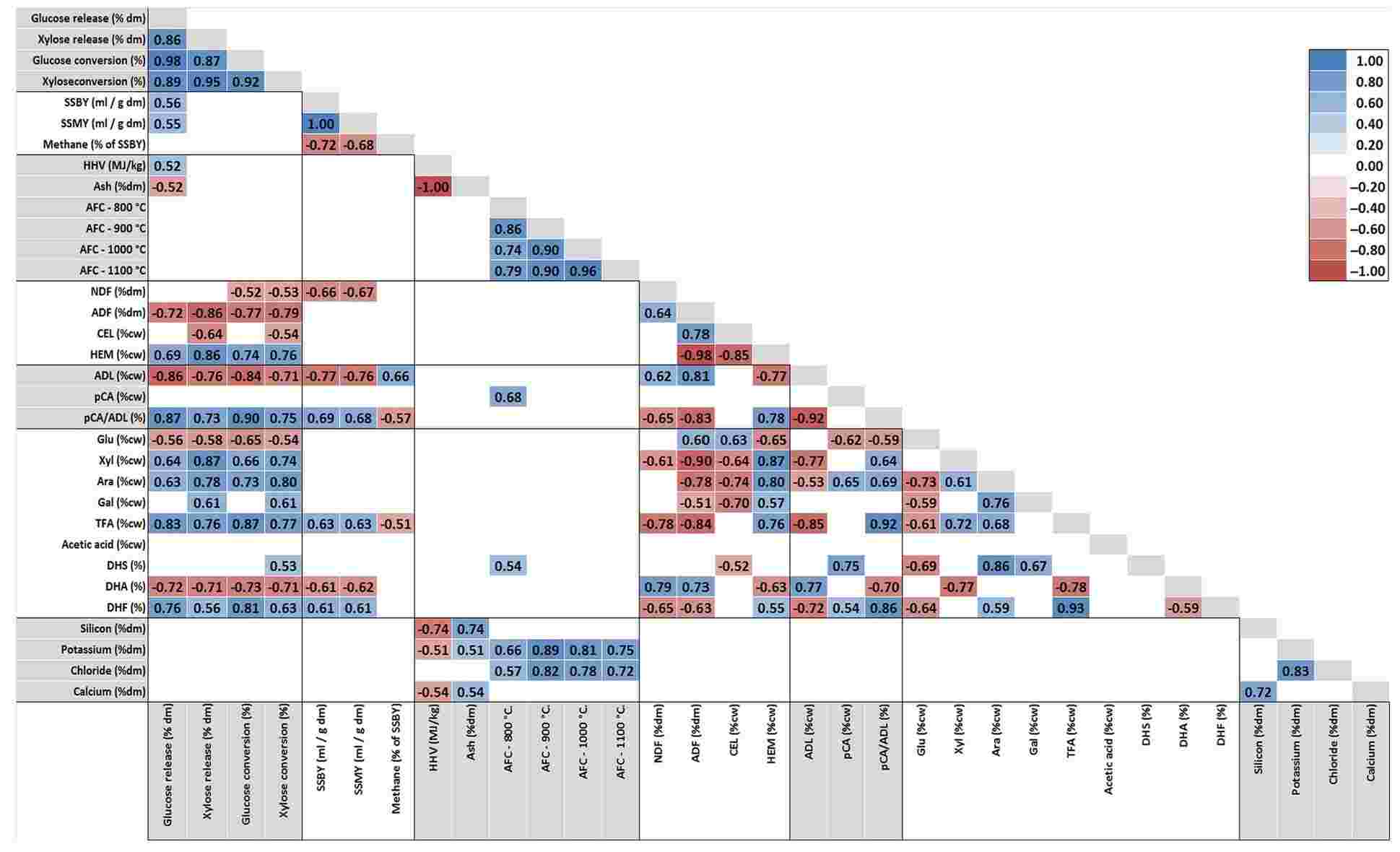Acetyl Group Analysis Service
Trust Our Acetyl Group Analysis for Reliable Result
Lignocellulose is an important alternative source of bioenergy. The acetylation level of the compounds contained therein affects the conversion of lignocellulose. Therefore, efficient acetyl content analysis is necessary for the utilization of lignocellulose. Creative Biolabs provides a professional, reliable, and efficient acetyl group analysis service to support clients' research on the acetylation level and conversion process of lignocellulose.
Accurate determination of acetyl content in Lignocellulosic and other Biomasses plays an important role in cost-effectively improving the performance of biomass pretreatment and conversion processes. We use an efficient and accurate ion-exchange chromatography (ICE) method to determine acetyl content in biomass such as lignocellulose, etc. Like Ash Analysis, Lignocellulosic Sugar Analysis, Uronic Acid Analysis, etc., our acetyl content analysis method has been optimized and validated. It has the advantages of convenience and accuracy and is suitable for batch testing of samples.
The determination of acetyl content in biomass samples such as lignocellulose using ICE is mainly performed by converting acetyl to acetic acid. First, we pretreat the samples at high temperatures to convert acetyl to acetic acid. After that, we use ICE to determine the acetic acid content in the treated samples. The exact acetic acid content is determined by comparing the peak area of acetic acid in the feed sample with the peak area of a known acetic acid standard. Finally, the acetyl content of the samples is determined by correcting for the molecular weight difference between acetic acid and acetyl group.
 Fig.1 Flowchart of the optimized acetyl content analysis.
Fig.1 Flowchart of the optimized acetyl content analysis.
Advantages of Acetyl Content Analysis Service
-
Reliable and efficient analytical method: Our acetyl content analysis method has a high recovery rate, and is accurate and reliable.
-
Real-time tracking of analysis projects: We have a very comprehensive project management system to track the progress of projects in real time.
-
Experienced in analysis: We are experienced in acetyl content analysis and efficiently solve any problems encountered.
Creative Biolabs provides a professional acetyl content analysis for many lignocellulosic and other biomasses according to reproducible and stable analytical systems. Our analytical team will develop a custom analysis plan according to the client's needs and sample type. Please feel free to contact us for more details if you are interested in our acetyl content analysis service or have any questions.
Published data
Lignocellulosic biomass has a wide range of applications, such as those used as biofuels, production of biochemicals such as methane and ethanol, and saccharification. This study comprehensively shows us how the potential of biomass as a feedstock for conversion into different energy products can be assessed by analyzing changes in lignocellulosic composition. The researchers examined the monosaccharide composition, acetyl group content on monosaccharides, ash, and inorganic element content in the cell wall of Miscanthus sinensis, etc. In addition to this, their saccharification efficiency was also analyzed, among others. Eventually, it was found that the differences in biomass quality of different genotypes were closely related to the differences in biomass composition. The high content of hemicellulosic polysaccharides would positively affect the saccharification efficiency. This study provided good data support for the optimization and utilization of M. sinensis biomass in applications. It also provided a basis for us to detect and analyze acetyl content.
 Fig.2 Degree of correlation between biomass composition and biomass quality characteristics.1, 2
Fig.2 Degree of correlation between biomass composition and biomass quality characteristics.1, 2
FAQs
Q1: What is the impact of acetylation on the utilization of lignocellulose, etc.?
A1: As an important alternative source of bioenergy, biomass such as lignocellulose contains a large number of acetyl groups. It is found that the presence of acetyl affects the efficiency of carbohydrate saccharification during enzymatic hydrolysis of biomass, and also has an impact on fermentation. This ultimately makes the conversion of biomass to biofuels or the production of biochemicals from biomass more difficult. Therefore, there is a need to detect acetyl content during processing to understand better the role of acetyl groups in biomass pretreatment and hydrolysis and to develop good control strategies.
Q2: What are the current methods for measuring acetyl content in biomass?
A2: Currently there are more methods used to measure acetyl content in biomass such as lignocellulose and its derived solid or liquid samples. Among them, separation-based techniques are more frequently applied, such as gas chromatography and ICE. The principle of the determination is to convert the acetyl group in the sample to acetic acid or acetate by pretreatment under an alkaline or strong acidic medium and then determine it.
Customer Review
Meeting the Sample Batch Testing
"Our sample volume was relatively large, so we chose to work with Creative Biolabs. We were very satisfied with their acetyl content analysis service. In addition to the very efficient analysis of our biomass samples, the lab report was very clear and detailed, which helped us to make an accurate judgment on the degree of acetylation of the samples."
Very Professional Lab Technicians
"The staff at Creative Biolabs is very professional and responsive. Their knowledge of all aspects of biomass is evident from the acetyl content analysis service they provided to us. We were also very satisfied with their commitment to delivering results within the specified time frame and the efficiency of their analysis. Their reliable and quality service was instrumental in moving our project forward."
References
-
Van der Weijde, Tim, et al. "Evaluation of Miscanthus sinensis biomass quality as feedstock for conversion into different bioenergy products." Gcb Bioenergy 9.1 (2017): 176-190.
-
Under Open Access license CC BY 4.0, without modification.
For Research Use Only.
Related Services

 Fig.1 Flowchart of the optimized acetyl content analysis.
Fig.1 Flowchart of the optimized acetyl content analysis.
 Fig.2 Degree of correlation between biomass composition and biomass quality characteristics.1, 2
Fig.2 Degree of correlation between biomass composition and biomass quality characteristics.1, 2



